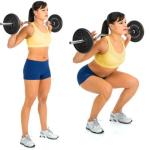When I’m in the gym with my clients they will sometimes ask me if there is any significant difference between the squat and leg press with respect to the muscles involved and if they can get by with doing one or the other, or is it best that they need to perform both?
My response to them is If they’re wanting optimal leg mass and development, they must use a variety of leg exercises, including the squat and leg press. Although both exercises work essentially the same muscles, the emphasis of each is slightly different, which means muscle development is different as well.
THE SQUAT
The squat, known as the granddaddy of all bodybuilding exercises, simultaneously works more major muscles than any other resistance-training movement. The quadriceps (quads), hamstrings and gluteus maximus (glutes) are specifically targeted, while the hip and torso muscles are incorporated for stabilization and to assist the primary muscles. You can see why many experts in weight training consider the squat to be a whole-body exercise, even though you utilize it as a lower-body move.
Stabilizer muscles are smaller—and often less visible—muscles called upon during free-weight exercises to provide support and prevent unwanted movement. This is the rationale for utilizing free weights over machines (multi-joint exercises). To perform the squat safely and effectively, the abdominal muscles (including the rectus abdominis, external and internal obliques and the transverse abdominis) and spinal erectors of the lower back contract isometrically to hold the torso in place as movement occurs at the hips and knees. Likewise, the hip muscles contract to hold the hip girdle stationary, allowing only the desired movement (hip flexion and extension).
The squat range of motion (ROM) about the knee and hip joints is relatively large. Increased ROM translates into greater muscle activation and ultimately into superior muscle development. In particular, the wide ROM at the hip is what notably differentiates the squat from the leg press.
LEG PRESS
Because hip range of motion (ROM) is less for the leg press than it is for the squat, hamstring and glute contribution is greatly reduced. Also limited are hip adductor (inner thigh) recruitment and stabilizer muscle involvement, the latter due to the upper-body support provided by the leg press seat. But don’t dismiss the leg press as inferior and discard it from your routine—its one redeeming factor is superior quad development.
With the reduced hamstring, glute, adductor and stabilizer involvement you get when you perform the press, a greater percentage of the load is lifted by the quads. The leg press specializes in more direct targeting of the quad muscles and allows you to really hit ’em hard by over-loading them with a tremendous amount of weight. As great as the squat is, it just can’t blast specifically the quads quite like the leg press can.
Dual Quads
Now you can see why you don’t want to trust incredible leg development to just one of these capable quad killers. While the squat is said to be king, the leg press is no joker. Include both of these exercises in your routine to ensure that you don’t fall short of your true potential. Either alternate your squat and leg press days, or go the route many of the pros do—follow squats with more punishment via the leg press in the same workout. Either way, your legs will reap the benefits of diversity.
Squat Benefits
- Greater hip range of motion (ROM) enhances hamstring and glute development.
- Increased stabilizer and assistant muscle involvement improves overall strength and mass.
- Hip adductor (inner thigh) involvement contributes to overall leg size.
- No specialized equipment or apparatus required.
- More bang for the buck: You target several leg and torso muscles with one exercise.
Leg Press Benefits
- Leg press apparatus provides proper positioning and safety.
- Maximal weight can be used to overload the target muscle group (quads).
- Minimal stabilizer and assistant muscle involvement increases emphasis on the quads.
- Limited involvement of glutes and hamstrings leads to concentrated quad development.
- Foot plate allows you to shift the emphasis on the leg muscles by changing foot position.
Duane De Jager, M.Ed., BPE, B.Ed.
Categories: Exercise, FitPro Consulting







WOW just what I was searching for. Came here by searching for cat